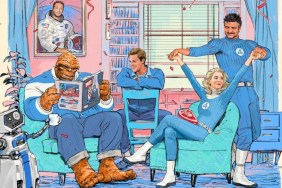Poster art compilation now available

Making a Christmas list? Good. Put “The Art of Hammer” in bold letters and in all caps at the top of that list. Titan Books and Marcus Hearn have compiled another incredible look back at the Hammer Films legacy after releasing “The Hammer Story” and “Hammer Glamour.” This time, the focus lies solely on the baroque, sometimes sexy, sometimes sensational, sometime grotesque poster art that heralded a Hammer Films release in theaters. It’s a look back at a time when poster art mattered. Before Photoshop and “floating heads” sold movies.
Shock caught up to Hearn to talk about his latest tome and to see why Hammer is so special to him.
Shock: Following the creation of “The Hammer Story” and “Hammer Glamour,” was “The Art of Hammer” the next obvious choice, or where there other options you wanted to explore in the world of Hammer?
Marcus Hearn: A book of Hammer posters seemed like the next obvious choice, really. I already had books of Hitchcock and Bond posters on my shelf, and wanted something similar that celebrated Hammer’s even broader legacy of advertising artwork. The idea had been in the back of my mind since we did “The Hammer Story” back in 1996, but I’d put it off because of the complications of plugging the gaps in Hammer’s archive and the technical challenge of restoring some of the more damaged posters. I didn’t want the Hammer book to be a poor relation of the books I’ve just mentioned, or indeed any of the other great film poster books that are out there. Hopefully “The Art of Hammer” looks at least as good as those books.

Shock: What set you on the path to exhaustively explore this house of horror and its legacy?
Hearn: It started back in 1994, when I worked for Marvel Comics and was given the job of editing the official Hammer magazine. I was a fan of the films, but the more I saw and the more I learned about the company, the more enthusiastic I became. I really enjoyed working with the people there, and I think over the years I’ve become something of an apologist for the old firm. I’m certainly happy to defend Hammer from critics who dismiss the films as b-movies. Many people in this country refer to some of the older films as “camp,” and that leaves me baffled.
Shock: “The Art of Hammer” is marvelously laid out. Talk about the design and were there any pieces that proved to be difficult to get a hold of for this book?
Hearn: The credit for this goes to a wonderful lady called Peri Godbold, who I’ve worked with since we did that Hammer magazine together back in 1994. She is a brilliant, intuitive and diligent designer, who’s also a big fan of the films. At the beginning of the project I decided that we should concentrate on British, and then American posters, and then supplement these with a selection from around the world. We made a survey of what was in Hammer’s archive, and then I approached some of the UK’s leading collectors to see if they could plug the gaps. We worked around what was available, and it was very difficult to decide what should go in and what should be left out. Some of the larger formats, especially those from Italy, were neglected partly because it was difficult to find copies in good condition and partly because of the problems their sheer size presented in photographing and scanning them.

Generally speaking, many of the British posters reflect the elegance and eroticism of the films. Their American counterparts are much more informed by the gimmicky drive-in culture that was prevalent in the US in the 1950s and ’60s. I say this is a generalization because some of the most understated and sophisticated posters came out of America in the late ’60s.
Shock: Any particular favorite posters in the collection and do you own any of the originals?
Hearn: I have a relatively modest collection of posters, and some of them are in the book. My favorites in the book are probably the She/One Million Years BC double bill from 1969 (“Hammer Glamour! Hammer Spectacular!”) and the black US one-sheet for Frankenstein Must Be Destroyed, which is what a Hammer poster would have looked like if Andy Warhol had designed it. It’s not a particularly rare poster, but I don’t own it and I’d like to. I think one of the great things about Hammer posters is that they’re a great entry-level collectible for people who are new to this type of memorabilia. Of course the rarest ones sell for five-figure sums, but if you’re patient you can still find some great pieces on eBay for relatively little.
Shock: Why does Hammer endure and why should a new generation of young horror fans be paying attention to these classics?
Hearn: I could talk about this forever, but suffice to say the best of these films are the best Gothic horror movies made anywhere, by anybody. Anyone who enjoys beautifully crafted horror films â and by that I mean suspense and not torture porn â would enjoy seeing how Universal and then Hammer laid the foundations for the modern genre.

Shock: As a fan, then, what do you think of Hammer’s resurrection?
Hearn: I think it was only natural to be wary at first, but the evidence of their care and commitment is on the screen. Let Me In is not really anything like Hammer ever made before but â and this is the important bit â it is an excellent horror film which is by no means a betrayal either. I’m really looking forward to seeing the next ones â The Resident, Wake Wood and especially The Woman in Black.
Shock: Any ideas on another Hammer tome you might be at work on?
Hearn: Hammer have invited us back into the archive for another book next year. It will be very different from the ones we’ve already produced, but will hopefully be a nice companion volume to what has gone before.




Source: Ryan Turek, Managing Editor









